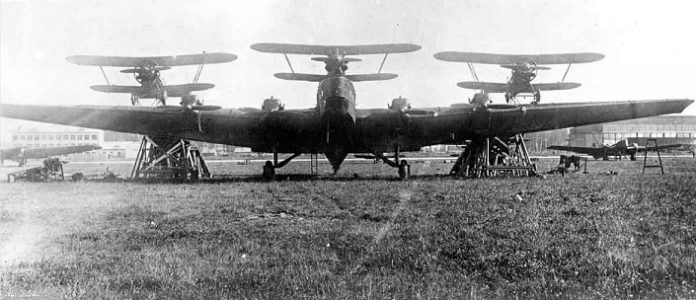
Weapons 20/03/20 As the Soviet aircraft carriers bombed Romania
the Air carriers is more common in science fiction novels, and many people believe that they belong there. Science fiction writers usually “adopt” something that was conceived and developed, but in a real war, did not participate.
However, the air carrier – is a real combat system, which not only flew in the sky, but fought.
the Idea of a aircraft carrier
the Idea of aircraft or flying aircraft carrier emerged in the First World war. The reason it was lagging behind the technical capabilities of the aircraft from the desires of the military. In particular, the desire to bomb the enemy targets in the rear, demanded protection for bombers, fighters and enemy interceptors. But the range of the fighters of that time were small. And considering that the heavy bombers in the first place was seen no planes, and airships, it is clear that a tiny fighter about such a range could not even dream of. But the huge size of the airships have suggested that the fighters they can carry.
In 1918, the Germans at one of their zeppelins raised in the air fighter “Albatross”. In flight, the “Albatross” unhooked and landed safely on the airfield. In the same year similar experiment was performed and the British. Although both experiments were successful, but only partially. Because the fighter was not just to disengage in the air from aircraft carrier to dogfight, but to go somewhere after the fight. That is, there was a question about that in the air to cling to the airship. And this question was not decided until the end of the war.
After the war, work continued in the United States, where he built two airship-carriers, but they were both killed in accidents, and in the fighting has not been applied
20 years actively promoted the idea of the aircraft carrier. According to the then theoreticians, large bombardirovnye air group was to include different types of heavy aircraft, including aircraft carriers. The latter had to carry a sufficient number of fighters to defend its aircraft from attacks by enemy interceptors. But all this remained at the level of theory, because none of the countries had in the interwar period its heavy bombers. Except the Soviet Union.
“the Circus vahmistrova”
In the USSR, the world’s most powerful bombers created in full compliance with all global trends. Its membership was to include a variety of bombers and air cruisers, long-range reconnaissance and targeting aircraft, airborne command posts and tankers. Not forgotten were the air carriers. Their development was occupied Vladimir Sergeyevich Vakhmistrov. The first project called “Link-1” provided for the use of bomber TB-1, on the wing which was installed two fighter-4. The first experiments showed that debonding in the air is extremely complicated and risky task. But there were no casualties and disasters. In any case, the bomber TB-1 was too small for such a project and with the advent of larger TB-3 work continued using it.
In different versions of the project “Link” (from the 1st to the 7th) has varied the type and amount of suspended fighters, they even considered a variant of ad in which there were eight And 16. Most of the projects were created to accompany the heavy bombers to protect them from enemy interceptors.
Only in the “Link-6” two-16 fighter was to be used as dive bombers. Their dive-bombers in the Soviet Union did not create, but fighters, even old-fashioned, well-suited for this role. The decision of Committee of defense of the USSR, the aircraft carrier under the name of “Link-SPB” (Composite Dive Bomber) was adopted and by early 1939 it was planned to be armed with 40 aircraft converted TB-3 (equally for the army and marine airtion) and 80-16 fighters for them.
the result, However, was created only one squadron in Yalta. First, the industry was overloaded and could not cope with many orders. Second, the vahmistrova demoted because of the arrest of his older brother.
according to V. Kotelnikov in “Flying aircraft carriers vahmistrova” tests have shown that although the tasks were solved, but mass use was far away. Unhitching and hitching to the fighter aircraft-the medium was a challenge even for experienced test pilots. A test Link was Chkalov, Stefanovsky, Kokkinaki, Suprunov, Susie. Not by chance the “Link” among the test pilots got the name “Circus vahmistrova”, and in naval aviation “Circus Subiceva” on behalf of the squadron commander.
on the one hand, the “Link” was allowed to give new life to a large number of older aircraft. On the other hand, the number of “Chkalov” and “Stephan” in the USSR was much less than these older aircraft. And that would be the story of “Link” is over, but then the war began.
“Link-SPB”
In July 1941, the year an important target for Soviet long range aviation now has become a strategic bridge over the Danube. Long-range bombers to destroy it could not, wanted something similar to the German “Thing”, capable of precision strikes. But nothing of the kind in the red army was not, and in any case, the range would be too big.
Then I remembered the “Link”, especially since the bridge was within his range. First I decided to check in combat for another purpose. The 26th of July, two aircraft carriers flew to the Romanian port of Constanta. Four I-16, which they carried on their wings were on the 250-kg bomb. Their goal was the port tanks. Everything related to the Romanian oil was closely guarded by German aircraft. But barrazhirovavshij “Messerschmitt” could not assume the presence of Soviet fighters at such distance from the base, and just ignored them. The result is bamby as the exercise went in goal, and four fighters of his course he returned to Odessa, and from there home to Yevpatoria.
the Bridge was bombed twice. The first time the 10th of August, but not very well. One aircraft carrier of the three actually was forced to return, significant damage to the bridge is not received, but all our planes without any losses returned to Odessa. 13th Aug still destroyed one farm bridge. Worked for six I-16 from three TB-3. Returned everything, and they even staged the attack Romanian infantry in Odessa.
17th August-six-16 smashed dock in Constanta, a week later, the carriers struck through the Dnieper, 28 August — Zaporozhe. 9 September four And-16 just bombed the crossing on the Dnieper, but also scored two shot down in combat “Messerschmitt”.
Evaluation of the actions of the Soviet flying aircraft carriers may be that Admiral Kuznetsov personally appealed to Stalin with a proposal to resume their production. But it was wrong.
exactly How many times off carriers is unknown, but it is believed that not less than thirty. The last departure date from the beginning of 1942, and that combat history of flying aircraft carriers over.
Cyril Shishkin
Source:
© Russian Seven
Recommended statesalaska… Share: Comments Comments on the article “How the Soviet air carriers bombed Romania” Please log in to leave a comment! br>
Share on Tumblr
















